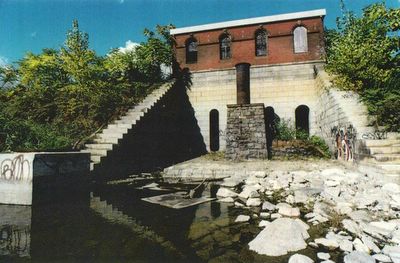Wednesday, May 18, 2005

Wednesday, May 18, 2005
Reservoir 3 Photos Courtesy Leon Yost One of the last of its kind in the United States, Reservoir 3 on Summit Avenue was built between 1851-74 as part of an extensive water works system that provided fresh drinking water to an expanding Jersey City and a busy immigration station known as Ellis Island. The design of the structure?s massive perimeter walls indicate influences of the Egyptian-Revival Style while its two pump houses are characterized by Romanesque-Revival features. Reservoir 3, emptied and unused, is now home to an emerging ecosystem, wetlands, and wildlife sanctuary. May 15, 2005 An Oasis of Wilderness, in the Middle of Jersey City? By PETER APPLEBOME Jersey City STEVE LATHAM had just finished giving an informal inventory of the fauna and flora flourishing against all odds in the oasis in the middle of Jersey City: red-tailed hawks and peregrine falcons, swans and egrets, perch and goldfish, red oaks and birch, mulberries and black cherry trees. And then suddenly, standing on a rock at the water's edge, as long, thin and angular as a great blue heron, he looked up as if stunned. "Look at this," he said, gesturing toward the black forms of a half-dozen good-size large-mouthed bass swimming near the shore at the abandoned city reservoir in the Jersey City Heights. "Look how big they are. It's amazing they're even there, and look how many. I've never seen them like this before." You would think that if anyone knew all there was to know about the secret world of Reservoir 3 - built from 1871 to 1880, abandoned and forgotten around 1989, and now suddenly a public crusade - it would be Steve Latham. Mr. Latham, 49, a restaurateur on hiatus from the restaurant business, first began to explore the abandoned 14.3 acres a few years back, adopted it as a place to kayak and teach his kids about nature, and then slowly turned it into something between a cause and an obsession. So there's a statistical possibility that even without his interest there might be a huge banner across Central Avenue reading: "Save Reservoir 3: Hidden Jewel of Jersey City," but it's far more likely that if it's still open space a decade from now, he and the residents working with him will have had a lot to do with it. The words "Jersey City" and "wilderness" go together about as naturally as "Paris Hilton" and "reclusive," but in this densely populated slice of Hudson County, an accident of history has allowed one almost-invisible oasis to exist in the middle of the city for almost its entire history. Reservoir 3 - not exactly a glamorous name but the only one it has ever had - was the third part of a system created to supply the city with water from the Passaic River. Built behind imposing 20-foot-high basalt walls in Egyptian Revival style, it has an air, in old drawings and photographs, of 19th-century elegance, with Oriental rugs in the brick pump house providing an atmosphere of rather stately repose. Eventually, water from the Boonton Reservoir replaced the increasingly dubious water from the Passaic, and it was finally closed altogether around 1989 - the water drained, the site padlocked, left behind like a spooky artifact from the city's past. There was talk of building homes on it, or ball fields, or developing it as the other two reservoirs had been. But it didn't happen, and even lifelong neighborhood residents never got a glimpse behind the walls. Mr. Latham, who grew up in the Finger Lakes region of upstate New York, decided to wander in a few times and saw the reservoir had filled naturally with snowmelt, spring water and rainwater. It had naturally reforested, it was full of wildlife, it was like a wild miracle in the middle of a congested city, with hawks circling overhead and the Empire State Building and the towers of Manhattan poking up in the distance. Not degraded, not developed, not tended. He was taken aback. "Here was this beautiful wild spot - not manicured, not planted, but planted by nature. It was this beautiful, secret spot, this very special place." SO he wrote a letter to the local newspaper about it, discussed it with friends, stirred up some interest and founded the Jersey City Reservoir Preservation Alliance. This year the organization, with about 50 active members, put together two public tours, the second one yesterday. They drew more than a thousand people, most of whom gawked in wonder at the hidden world in their midst. What happens next is not clear. There is no shortage of worthy suggestions for its use, particularly as a school or ball fields. And Mr. Latham's dream of a natural public park, with jogging trails, a waterfall, bridges, fishing, a boathouse and a windmill all ringing a pristine pond and wilderness preserve would cost millions, he admits. Still, if nothing else, he has helped make Jersey City's secret garden at least a public secret, a place that, if it ever goes, will not go quietly without a fight. "It's still a gorgeous urban oasis, but it's no longer a secret," said Mariano Vega, a City Council member who supports keeping land as pristine as possible. "They've got it on people's radar screen, which is a good thing. Because you can never again create something like that in Jersey City. Once it's gone, it's gone forever." E-mail: peappl@nytimes.com Copyright 2005 The New York Times Company Home Privacy Policy Search Corrections RSS Help Contact Us Back to Top
